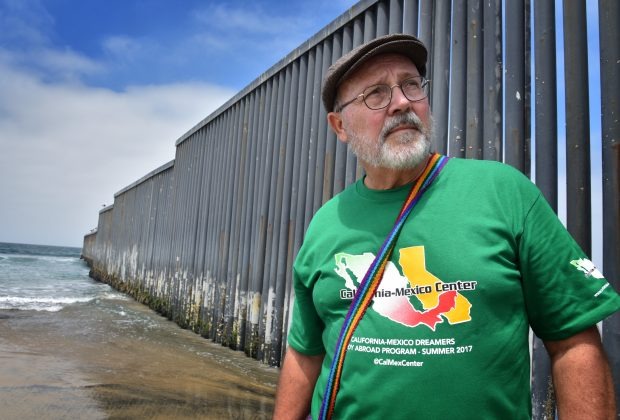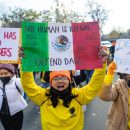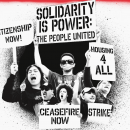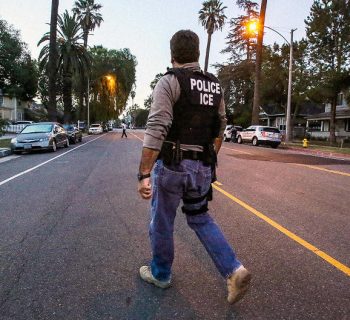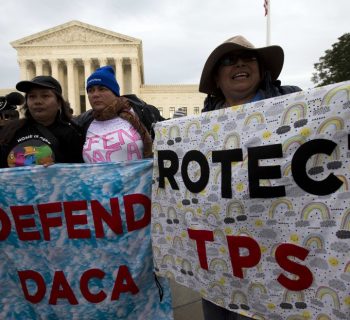By Professor Gonzalo Santos | May 1, 2024 | Photo Courtesy of Professor Gonzalo Santos
Seven years ago, in 2017, about a thousand folks marched & rallied in downtown Bakersfield on May Day, as far as I know the first - and only - time folks in this town proudly celebrated International Workers Day as such.
Most local unions and community-advocacy organizations declined to participate, but a highly-motivated and diverse group of activists responded favorably. The event was a great success. Hundreds marched around downtown Bakersfield, held a festive rally in Mill Creek park, and got great media coverage. A huge front page picture and story appeared on The Bakersfield Californian the next day.
The points of unity agreed upon by the organizers - see below - reflected a welcome intersectionality among them. This reflected a broadening of the meaning of the celebration from the earlier immigrant marches of 2006, which culminated with the May Day National Boycott for Immigrant Rights, when over two million immigrants and their allies marched in over 130 cities across the country - a stunning resurrection of May Day from the decades of oblivion during the Cold War. About 35,000 immigrants rallied in Bakersfield that May Day – the largest rally ever in the city’s history.
May Day is as American as apple pie. It originated back in 1890 as a day to honor the memory of the world-famous "Chicago Martyrs," the American workers who in 1886 rallied 80,000-strong at Haymarket Square to demand an 8-hour work day - a labor demand that had started in the US back in the mid-19 century (in the UK even earlier), only to be brutally attacked by the police, its labor leaders subsequently blamed for the violence, and executed.
Oddly, I knew all that labor history growing up in the Mexican port and major oil town of Tampico, in the Gulf of Mexico. Every May Day, as a little boy, I would watch startled from my grandmother's balcony how thousands of collective farmers (ejidatarios), oil workers (petroleros), dock workers (alijadores), and many others suddenly appeared pouring into downtown, pass by my balcony, marching in boisterous, disciplined, interminable contingents, each contingent chanting and carrying huge banners extolling their unions - and shouting chants about the "Chicago Martyrs" and "international workers' solidarity" ("¡Que vivan los mártires de Chicago!" "¡Que viva la solidaridad internacional de los trabajadores!").
Who, my boyhood mind wondered, were those "Chicago Martyrs," and why were they been so prominently honored by these throngs of proud and militant Mexican workers? The fact that they were American was even more intriguing to me, having grown up in a hyper-nationalist culture that revered its Mexican heroes and, furthermore, had such a widespread anti-imperialist defiant tradition. The only other foreigners I knew were honored like this were the "San Patricios" - the Irish American brigade that switched to the Mexican side in the U.S.-Mexico war.
As a boy growing up in the 1950s, visiting my warm and loving Mexican grandmother and gruff, expatriate Irish-American Republican grandfather, and my ballerina madrina who lived with them and frequently hosted her leftist artist friends, I quickly learned from their heated debates at the lunch table of the highly contested nature of this worldwide holiday that somehow originated in the U.S.A.
Many years later, when I came to the U.S. as a graduate student, I was surprised to discover practically no one knew about May Day, the "Chicago Martyrs," or anything else related with that working-class celebration - other than, in their minds, it was associated with the biggest military parade in Red Square, Moscow, the capital of the archrival and dreaded superpower, the U.S.S.R.; and since that parade usually displayed the latest, most menacing intercontinental nuclear missiles – expressively built to “deter” the Americans in their mutually-assured destruction, nuclear arms race – no one dared associate themselves with it!
That is, among the Americans I encountered, May Day was a threatening "Commie foreign celebration," and nothing could be more anti-American to them.
This view was held, to my shock, even among those in the labor movement, as well as those I encountered in the various other movements - like the Chicano and antiwar movements. They all pointed instead to Labor Day as their national holiday at the end of the summer, which they celebrated not with militant marches but family picnics and shopping sales.
Back in Mexico, though, the main plaza in Mexico City - the Zócalo - would swell up with hundreds of thousands of marching workers on every May Day (to clear things up: there was no military parade, that was Cinco de Mayo, which was adopted by the Chicano movement as an ethnic pride day). The workers’ contingents would march past Palacio Nacional and were saluted by the all-powerful Mexican president in turn, safely perched at his high balcony, in an apotheosis of a nationalist, working-class-State compact of mutual solidarity. No missiles or soldiers, just boisterous unions and their banners on the streets, under the Tlatoani’s approving gaze and endorsement. This went on from the 1920s to the 1980s.
In the 1990s, though, as single-party rule by the PRI became thoroughly delegitimized after it abandoned its nationalist, state-centered development project and embraced the U.S.-imported neoliberal globalization project, which badly impacted Mexican workers and peasants, the May Day parades served as the occasion for the workers to openly vituperate the president in turn, on national television no less. The ruler-ruled compact was broken.
And so, as May Day ceased to serve as the useful spectacle it had been, it was officially cancelled - something which, ironically, allowed May Day to return to its militant labor movement roots, fertilizing its many gardens of resistance autonomous from the State, where it blossoms today in Mexico’s independent labor movement, women’s movement, Indigenous movement, and others. It is better this way.
What about the peculiar story of May Day in the U.S., its prolonged erasure and studious avoidance by both the ruling duopoly in Washington and the U.S. labor movement; and then, unexpectedly, its incipient return to life in this new century, carried on the shoulders of Mexican, Salvadoran, Guatemalan, and many other militant migrants demanding their social and labor rights for too long denied?
Picking up the story just after the Haymarket Affair: May Day was first adopted as a yearly labor celebration in 1890 by the Second International (1889–1916), a Paris-based organization of socialist and labor parties. It soon spread as a labor holiday to most countries in the world.
Its main demand was the 8-hour work day, today an international labor norm (though frequently violated). Mexico enshrined it in its 1917 Constitution, a great achievement of the Mexican Revolution. In the U.S., there was a lengthy process of piecemeal adoption of the 8-hour day, which culminated in a New Deal federal law passed in 1937. It took the combative militancy of American workers during the Great Depression and a sympathetic Roosevelt administration to get it passed, over the strenuous opposition of the capitalist class.
But back in the 1890s, as the US labor movement gained strength, US President Grover Cleveland was one of those concerned that a labor holiday on May 1 would strengthen socialist and anarchist movements at the heart of the US labor movement. He advocated for a September Labor Day holiday instead, as a less inflammatory alternative. That September date was formally adopted as a United States federal holiday in 1894. After World War II, as the labor movement itself was tamed by the New Deal social contract during the Cold War era (1945-1993), Labor Day was reduced to nothing more than unofficial marking of the end of the Summer vacations, celebrated, as we said, more with family picnics and shopping sales than with militant collective actions of any kind.
Enter the modern immigrant rights movement into the picture in the 2000s. May Day became a day of collective mobilization for immigrant rights, which were and are inextricably linked with labor rights, human rights, and social rights, and in sharp contrast to the broader labor movement, imbued with a genuine sense of internationalist working-class solidarity. It sprung from the bottom up, suggested by the immigrant workers themselves as the day to march for their rights, resurrected like a phoenix from the ashes of an anemic U.S. labor movement.
May Day has now gone into temporary remission. In the intermediate years since the last May Day march in 2017, the Women's marches came and went. So did the immigrant marches, the Black Lives Matter marches, the gun-control marches, and the Climate marches. They should all soon re-appear, perhaps united where they left off from the last May Day.
During the pandemic, May Day was celebrated in some cities virtually, on the internet, or via "car caravans" – ingenious new modes of collective action during the times of terrible coronavirus. In L.A., all sorts of workers' solidarity events went on in defense of grocery workers and the other front line, essential but unprotected workers that helped us get through the crisis without much recognition or gratitude, many of whom were, you guessed it, immigrants.
I believe May Day is here to stay in the United States, back in starts and spurts primarily through the agency of immigrant workers, who are slowly teaching their recalcitrant American brother and sister workers the meaning of international worker solidarity as it was always meant to be, and as it should certainly be celebrated in this country built by immigrants. What could be more American?
Below is the set of “Principles of Unity” for the last May Day celebration I was involved organizing, the march & rally in Bakersfield in 2017. If another May Day celebration was to be held today, I would add five new demands:
- Immediate Presidential Pardon & Work Permits to All Undocumented Immigrants
- Stop the Genocide in Gaza – Immediate Cease Fire and Humanitarian Aid
- Stop the War & Negotiate the Peace in Ukraine
- Defend & Protect U.S. Democracy & Free Speech
- Restore Full Reproductive Rights to Women

